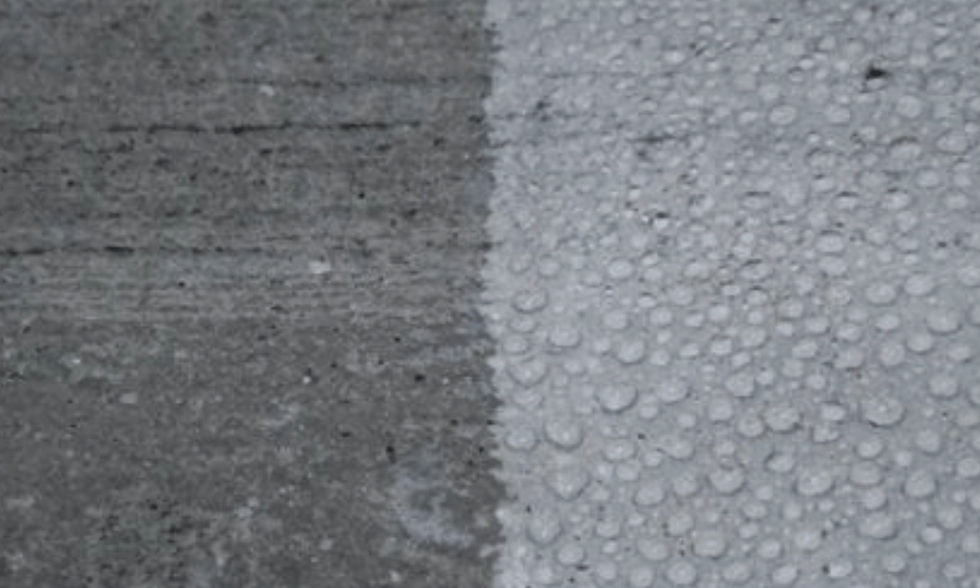How Crystalline Sealers Block Chloride & Water: A Deep Dive into PAVIX CCC 100
- The Field Foreman

- Jul 19
- 3 min read
Updated: Jul 21
Concrete is tough—but not invincible. Chloride ions, de‑icing salts, and freeze–thaw cycles slowly erode its internal matrix, corroding rebar and spawning costly repairs. A crystalline concrete sealer such as PAVIX CCC 100 solves the problem from the inside out: it migrates deep into the capillaries, forms insoluble crystals, and turns the slab itself into a permanent waterproofing barrier.

1. The Chemistry Behind Crystalline Waterproofing
Penetration & Reaction
PAVIX‑generated molecules, carried by water, migrate up to 30 cm (12 in) inside concrete.
They react with free calcium hydroxide [Ca(OH)₂] to form calcium silicate hydrate (C‑S‑H) crystals.
Pore Blocking
Growing crystals fill capillaries and micro‑cracks down to 0.4 mm, reducing permeability by > 90 % compared with untreated slabs.
The process is catalytic: moisture arriving later re‑activates unreacted particles, offering a “self‑healing” effect.
Chloride Rejection
With pores narrowed or sealed, chloride ions can no longer diffuse to reinforcement steel, dropping corrosion potential dramatically.
Lab tests show chloride penetration values < 190 C (ASTM C1202 rapid chloride test), versus 2 000 C‑plus for ordinary concrete.
2. Lab Data Snapshot
Data compiled from Chem‑Crete PAVIX CCC 100 internal reports and independent DOT studies.
3. Field Case Studies
3.1. Anthony Henday Drive Bridge Deck – Edmonton, AB
Problem: Salt‑laden spray and freeze–thaw spalling after only eight winters.
Solution: One‑coat spray application of PAVIX CCC 100 at 220 ft²/US gal.
Outcome: Chloride content at rebar depth dropped from 1.2 % to 0.12 % (w/w) after two years; no new delamination detected in GPR scan.
3.2. Downtown Parkade Retrofit – Calgary, AB
Problem: Continuous water ingress from vehicle traffic and high CO₂ levels corroding rebar.
Solution: Pressure‑wash surface, repair cracks, apply two wet‑on‑wet coats of PAVIX CCC 100.
Outcome: Water absorption fell by 78 %; carbon‑steel half‑cell potentials shifted from ‑450 mV to ‑160 mV, indicating passivation of corrosion activity.
3.3. Light‑Rail Station Platforms – Portland, OR
Problem: Surface scaling and slip hazards caused by winter de‑icers.
Solution: Night‑shift application of PAVIX CCC 100 followed by 24‑h cure.
Outcome: Visual scaling eliminated after three winters; slip coefficient remained ≥ 0.60 (ASTM D2047).
4. Installation Best Practices
Surface Prep – Remove surface sealers, laitance, and oil; substrate must be clean and saturated‑surface‑dry (SSD).
Application Rate – 180–250 ft²/gal per coat; two coats wet‑on‑wet recommended for structures exposed to de‑icing salts.
Cure Time – Protect from heavy traffic and rain for 4 hours; full crystallization reaches peak performance in 30 days.
Compatibility – Safe under epoxy overlays, paints, or tile; always test adhesion if additional finishes are planned.
5. FAQs
6. Why Crystalline ≠ Topical Sealers
Permanent, not sacrificial – No re‑coats every 2–5 years.
Breathable – Allows water vapour to escape, avoiding freeze–thaw pop‑outs.
Self‑healing – Reactivates when cracks form and water re‑enters.
7. Ready to Waterproof Your Concrete?
Stop chloride corrosion before it starts. Book a complimentary on‑site waterproofing assessment and receive a tailored specification for PAVIX CCC 100.


